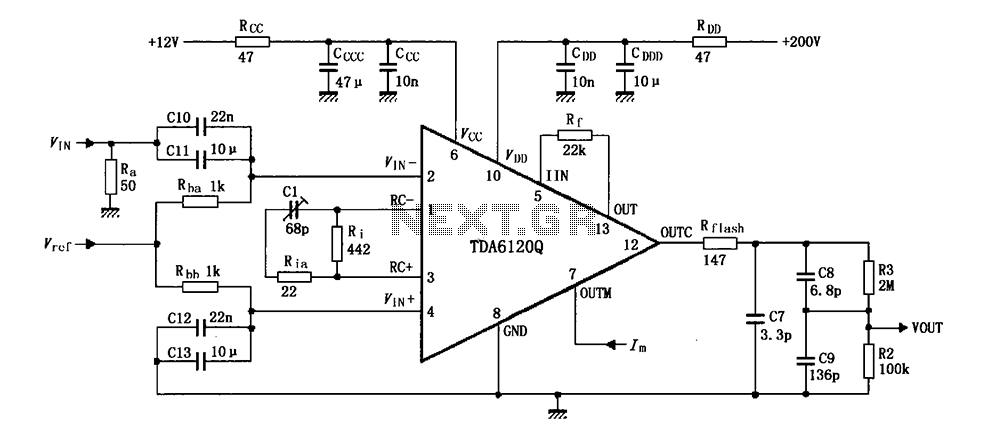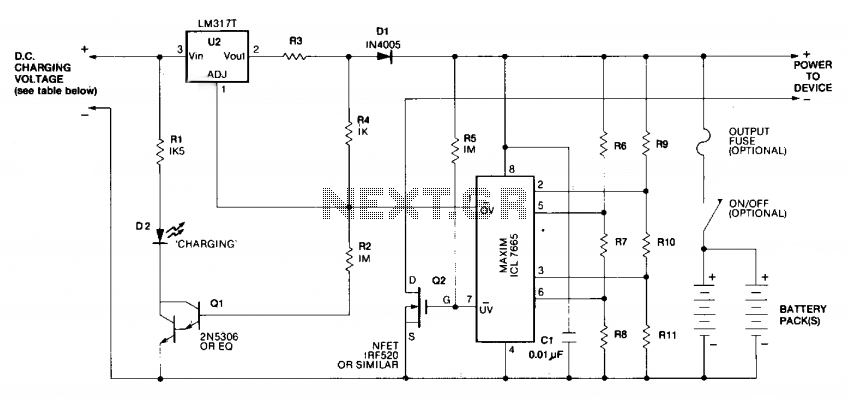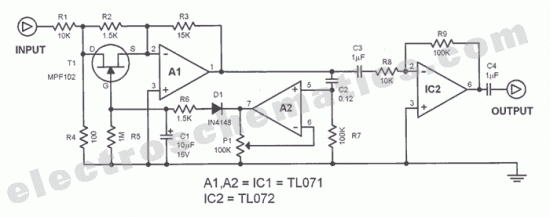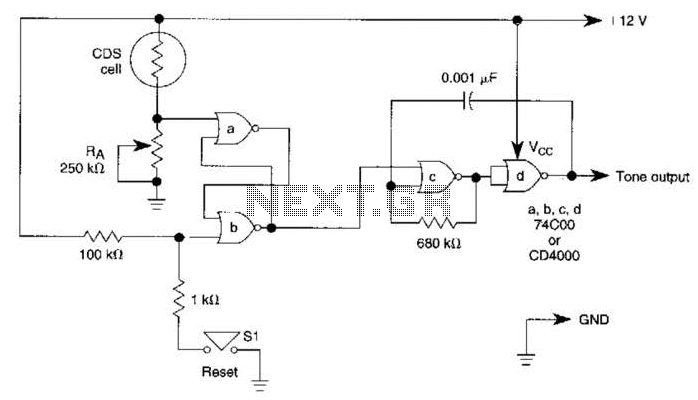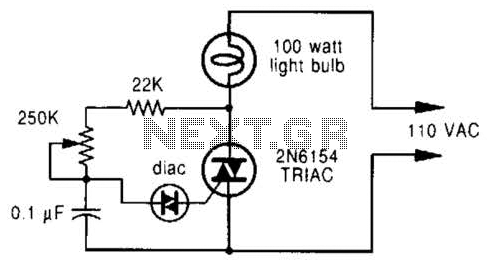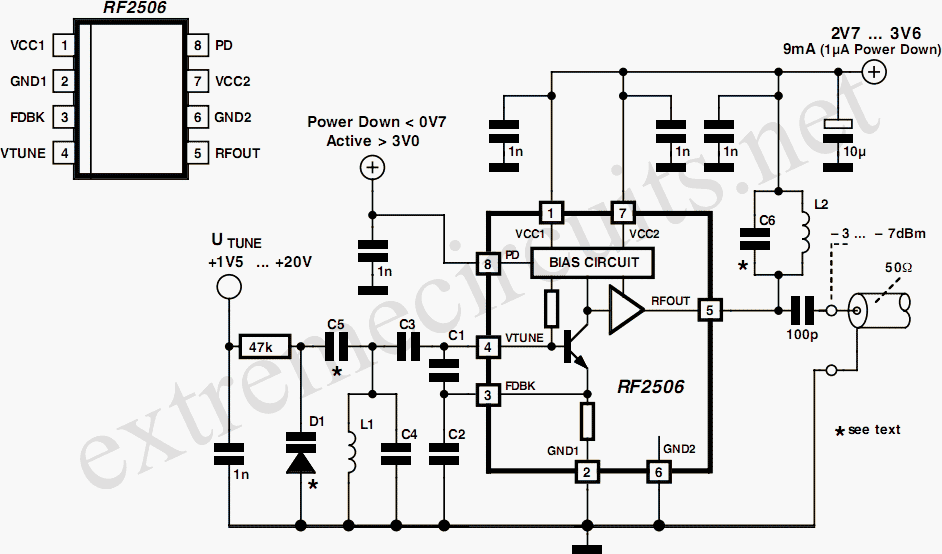
Infrared Headphone Amplifier circuit
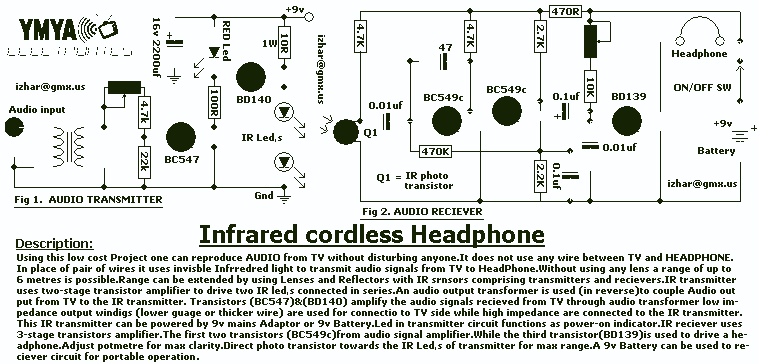
Using this low cost project, one can reproduce audio from a TV without disturbing anyone. It does not use any wire between the TV and headphones. Instead of a pair of wires, it uses invisible infrared light to transmit audio signals from the TV to the headphones. Without using any lens, a range of up to 6 meters is possible. The range can be extended by using lenses and reflectors with IR sensors comprising transmitters and receivers. The IR transmitter uses a two-stage transistor amplifier to drive two IR LEDs connected in series. An audio output transformer is used (in reverse) to couple audio output from the TV to the IR transmitter. More: Transistors (BC547) and (BD140) amplify the audio signals received from the TV through the audio transformer. Low impedance output windings (lower gauge or thicker wire) are used for connection to the TV side while high impedance is connected to the IR transmitter. This IR transmitter can be powered by a 9V mains adaptor or a 9V battery. An LED in the transmitter circuit functions as a power-on indicator. The IR receiver uses a three-stage transistor amplifier. The first two transistors (BC549C) form the audio signal amplifier, while the third transistor (BD139) is used to drive a headphone. An adjustable potentiometer is included for maximum clarity. The photo transistor should be directed towards the IR LEDs of the transmitter for maximum range. A 9V battery can be used for the receiver circuit for portable operation.
The described project is an infrared audio transmission system that enables wireless audio reproduction from a television to a pair of headphones. The system consists of two main components: the IR transmitter and the IR receiver.
The IR transmitter is designed to capture audio signals from the TV using an audio output transformer. This transformer is connected in reverse, allowing it to couple the audio output from the TV to the transmitter circuit. The audio signal is then amplified using a two-stage transistor amplifier, which utilizes transistors BC547 and BD140. These transistors are responsible for increasing the audio signal strength before it drives two infrared LEDs that are connected in series. The transmitter can be powered by either a 9V mains adaptor or a 9V battery, providing flexibility in power source selection. An LED indicator is integrated into the transmitter circuit to signify when the system is powered on.
The IR receiver is equipped with a three-stage transistor amplifier, with the first two transistors (BC549C) dedicated to amplifying the audio signal received from the IR LEDs. The third transistor (BD139) serves the purpose of driving the headphones. An adjustable potentiometer is included in the receiver circuit to allow users to fine-tune the audio output for optimal clarity. To ensure maximum transmission range, the photo transistor within the receiver should be oriented towards the IR LEDs of the transmitter. The system is capable of operating at a distance of up to 6 meters without any lenses, although the range can be extended with the use of lenses and reflectors. Additionally, the receiver can also be powered by a 9V battery, making the entire system suitable for portable applications.
This infrared audio transmission system provides a practical solution for listening to television audio without disturbing others, making it ideal for use in shared living spaces or during late-night viewing.Using this low cost Project one can reproduce AUDIO from TV without disturbing anyone. It does not use any wire between TV and HEADPHONE. In place of pair of wires it uses invisible Infrared light to transmit audio signals from TV to Headphone. Without using any lens a range of up to 6 meters is possible. Range can be extended by using Lenses and Reflectors with IR sensors comprising transmitters and receivers.
IR transmitter uses two-stage transistor amplifier to drive two IR leds connected in series. An audio output transformer is used (in reverse) to couple Audio output from TV to the IR transmitter. Transistors (BC547) & (BD140) amplify the audio signals received from TV through audio transformer low impedance output windings (lower gauge or thicker wire) are used for connection to TV side while high impedance are connected to the IR transmitter. This IR transmitter can be powered by 9v mains Adaptor or 9v Battery. Led in transmitter circuit functions as power-on indicator. IR receiver uses 3-stage transistors amplifier. The first two transistors (BC549c)from audio signal amplifier. While the third transistor(BD139)is used to drive a headphone. Adjust potmetre for max clarity. Direct photo transistor towards the IR Leds of transmitter for max range. A 9v Battery can be used to receiver circuit for portable operation 🔗 External reference
The described project is an infrared audio transmission system that enables wireless audio reproduction from a television to a pair of headphones. The system consists of two main components: the IR transmitter and the IR receiver.
The IR transmitter is designed to capture audio signals from the TV using an audio output transformer. This transformer is connected in reverse, allowing it to couple the audio output from the TV to the transmitter circuit. The audio signal is then amplified using a two-stage transistor amplifier, which utilizes transistors BC547 and BD140. These transistors are responsible for increasing the audio signal strength before it drives two infrared LEDs that are connected in series. The transmitter can be powered by either a 9V mains adaptor or a 9V battery, providing flexibility in power source selection. An LED indicator is integrated into the transmitter circuit to signify when the system is powered on.
The IR receiver is equipped with a three-stage transistor amplifier, with the first two transistors (BC549C) dedicated to amplifying the audio signal received from the IR LEDs. The third transistor (BD139) serves the purpose of driving the headphones. An adjustable potentiometer is included in the receiver circuit to allow users to fine-tune the audio output for optimal clarity. To ensure maximum transmission range, the photo transistor within the receiver should be oriented towards the IR LEDs of the transmitter. The system is capable of operating at a distance of up to 6 meters without any lenses, although the range can be extended with the use of lenses and reflectors. Additionally, the receiver can also be powered by a 9V battery, making the entire system suitable for portable applications.
This infrared audio transmission system provides a practical solution for listening to television audio without disturbing others, making it ideal for use in shared living spaces or during late-night viewing.Using this low cost Project one can reproduce AUDIO from TV without disturbing anyone. It does not use any wire between TV and HEADPHONE. In place of pair of wires it uses invisible Infrared light to transmit audio signals from TV to Headphone. Without using any lens a range of up to 6 meters is possible. Range can be extended by using Lenses and Reflectors with IR sensors comprising transmitters and receivers.
IR transmitter uses two-stage transistor amplifier to drive two IR leds connected in series. An audio output transformer is used (in reverse) to couple Audio output from TV to the IR transmitter. Transistors (BC547) & (BD140) amplify the audio signals received from TV through audio transformer low impedance output windings (lower gauge or thicker wire) are used for connection to TV side while high impedance are connected to the IR transmitter. This IR transmitter can be powered by 9v mains Adaptor or 9v Battery. Led in transmitter circuit functions as power-on indicator. IR receiver uses 3-stage transistors amplifier. The first two transistors (BC549c)from audio signal amplifier. While the third transistor(BD139)is used to drive a headphone. Adjust potmetre for max clarity. Direct photo transistor towards the IR Leds of transmitter for max range. A 9v Battery can be used to receiver circuit for portable operation 🔗 External reference
Warning: include(partials/cookie-banner.php): Failed to open stream: Permission denied in /var/www/html/nextgr/view-circuit.php on line 713
Warning: include(): Failed opening 'partials/cookie-banner.php' for inclusion (include_path='.:/usr/share/php') in /var/www/html/nextgr/view-circuit.php on line 713
